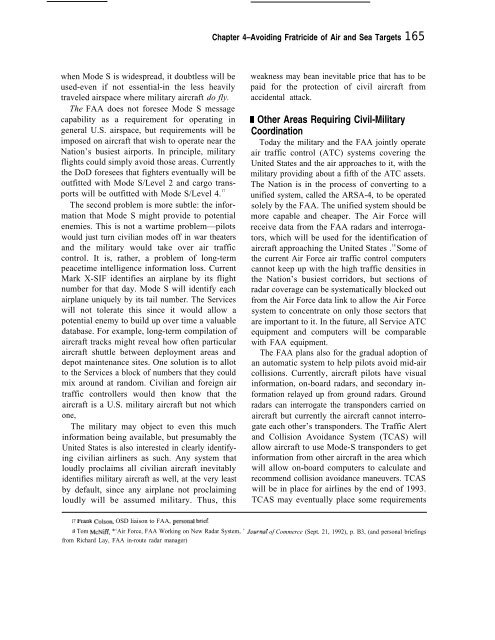Who Goes There: Friend or Foe? - Federation of American Scientists
Who Goes There: Friend or Foe? - Federation of American Scientists
Who Goes There: Friend or Foe? - Federation of American Scientists
Create successful ePaper yourself
Turn your PDF publications into a flip-book with our unique Google optimized e-Paper software.
when Mode S is widespread, it doubtless will be<br />
used-even if not essential-in the less heavily<br />
traveled airspace where military aircraft do fly.<br />
The FAA does not f<strong>or</strong>esee Mode S message<br />
capability as a requirement f<strong>or</strong> operating in<br />
general U.S. airspace, but requirements will be<br />
imposed on aircraft that wish to operate near the<br />
Nation’s busiest airp<strong>or</strong>ts. In principle, military<br />
flights could simply avoid those areas. Currently<br />
the DoD f<strong>or</strong>esees that fighters eventually will be<br />
outfitted with Mode S/Level 2 and cargo transp<strong>or</strong>ts<br />
will be outfitted with Mode S/Level 4. 17<br />
The second problem is m<strong>or</strong>e subtle: the inf<strong>or</strong>mation<br />
that Mode S might provide to potential<br />
enemies. This is not a wartime problem—pilots<br />
would just turn civilian modes <strong>of</strong>f in war theaters<br />
and the military would take over air traffic<br />
control. It is, rather, a problem <strong>of</strong> long-term<br />
peacetime intelligence inf<strong>or</strong>mation loss. Current<br />
Mark X-SIF identifies an airplane by its flight<br />
number f<strong>or</strong> that day. Mode S will identify each<br />
airplane uniquely by its tail number. The Services<br />
will not tolerate this since it would allow a<br />
potential enemy to build up over time a valuable<br />
database. F<strong>or</strong> example, long-term compilation <strong>of</strong><br />
aircraft tracks might reveal how <strong>of</strong>ten particular<br />
aircraft shuttle between deployment areas and<br />
depot maintenance sites. One solution is to allot<br />
to the Services a block <strong>of</strong> numbers that they could<br />
mix around at random. Civilian and f<strong>or</strong>eign air<br />
traffic controllers would then know that the<br />
aircraft is a U.S. military aircraft but not which<br />
one,<br />
The military may object to even this much<br />
inf<strong>or</strong>mation being available, but presumably the<br />
United States is also interested in clearly identifying<br />
civilian airliners as such. Any system that<br />
loudly proclaims all civilian aircraft inevitably<br />
identifies military aircraft as well, at the very least<br />
by default, since any airplane not proclaiming<br />
loudly will be assumed military. Thus, this<br />
17 Frti COISO~ OSD liaison to FAA, persOnal brief.<br />
Chapter 4–Avoiding Fratricide <strong>of</strong> Air and Sea Targets 165<br />
weakness may bean inevitable price that has to be<br />
paid f<strong>or</strong> the protection <strong>of</strong> civil aircraft from<br />
accidental attack.<br />
fl Other Areas Requiring Civil-Military<br />
Co<strong>or</strong>dination<br />
Today the military and the FAA jointly operate<br />
air traffic control (ATC) systems covering the<br />
United States and the air approaches to it, with the<br />
military providing about a fifth <strong>of</strong> the ATC assets.<br />
The Nation is in the process <strong>of</strong> converting to a<br />
unified system, called the ARSA-4, to be operated<br />
solely by the FAA. The unified system should be<br />
m<strong>or</strong>e capable and cheaper. The Air F<strong>or</strong>ce will<br />
receive data from the FAA radars and interroga-<br />
t<strong>or</strong>s, which will be used f<strong>or</strong> the identification <strong>of</strong><br />
aircraft approaching the United States . 18<br />
Some <strong>of</strong><br />
the current Air F<strong>or</strong>ce air traffic control computers<br />
cannot keep up with the high traffic densities in<br />
the Nation’s busiest c<strong>or</strong>rid<strong>or</strong>s, but sections <strong>of</strong><br />
radar coverage can be systematically blocked out<br />
from the Air F<strong>or</strong>ce data link to allow the Air F<strong>or</strong>ce<br />
system to concentrate on only those sect<strong>or</strong>s that<br />
are imp<strong>or</strong>tant to it. In the future, all Service ATC<br />
equipment and computers will be comparable<br />
with FAA equipment.<br />
The FAA plans also f<strong>or</strong> the gradual adoption <strong>of</strong><br />
an automatic system to help pilots avoid mid-air<br />
collisions. Currently, aircraft pilots have visual<br />
inf<strong>or</strong>mation, on-board radars, and secondary inf<strong>or</strong>mation<br />
relayed up from ground radars. Ground<br />
radars can interrogate the transponders carried on<br />
aircraft but currently the aircraft cannot interrogate<br />
each other’s transponders. The Traffic Alert<br />
and Collision Avoidance System (TCAS) will<br />
allow aircraft to use Mode-S transponders to get<br />
inf<strong>or</strong>mation from other aircraft in the area which<br />
will allow on-board computers to calculate and<br />
recommend collision avoidance maneuvers. TCAS<br />
will be in place f<strong>or</strong> airlines by the end <strong>of</strong> 1993.<br />
TCAS may eventually place some requirements<br />
1S Tom McNiff, *‘Air F<strong>or</strong>ce, FAA W<strong>or</strong>king on New Radar System, ’ JournaZ <strong>of</strong> Commerce (Sept. 21, 1992), p. B3, (and personal briefings<br />
from Richard Lay, FAA in-route radar manager)
















